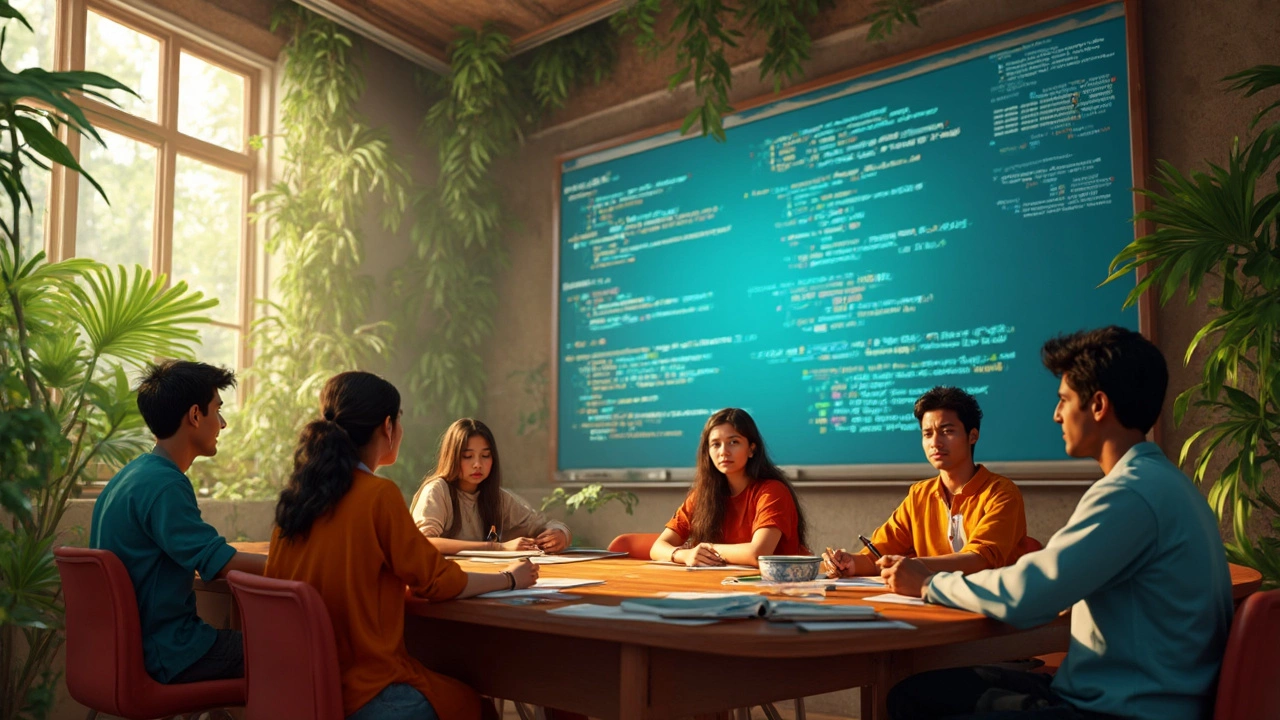If you're comfy with JavaScript and curious about exploring Python, you're in for an interesting adventure. While these languages serve different needs, they're not worlds apart, especially if you already have a handle on JS basics. Both focus on simplicity and readability, which is a big win for developers.
Here's a cool fact: Python ranks high for its straightforward syntax—a bit like writing in plain English. While JS is event-driven and embraces both functional and OOP styles, Python offers an equally flexible, sometimes more intuitive, environment. Transitioning doesn't mean starting from scratch.
Let's break down some practical differences. In JS, those curly braces and semicolons are your pals; in Python, it's all about indentation to control the flow. Forgetting a colon or adding too many tabs could throw you off at first, but you'll get the hang of it. Think of Python as a strict teacher ensuring your code is neat and tidy.
- Language Similarities
- Syntax Differences
- Python's Indentation
- Error Handling in Python
- Practical Tips for Transition
- Resources to Boost Learning
Language Similarities
Both Python and JavaScript have carved out a reputation for their accessibility and ease of learning. This makes them great first languages for budding coders and a manageable transition for seasoned developers.
One similarity you'll find is their emphasis on readability and simplicity. Python is famous for its clean syntax that feels almost like writing in plain English. Similarly, JavaScript is known for being forgiving and easily understood by beginners. This focus on clear code structures makes both languages attractive for those starting in the coding world.
Dynamic Typing
Both languages use dynamic typing, which means you don't have to declare variable types in advance. Just assign a value, and you're good to go. This flexibility can significantly speed up development time and help keep your code short and sweet.
Interpreted Languages
Another parallel is that they are both interpreted languages. This means you don't have to compile the code before running it. It executes directly, which is great for testing and quick iterations. Change something, run it, see what happens—it's a cycle that encourages experimentation and faster learning.
Check out this quick comparison:
| Feature | Python | JavaScript |
|---|---|---|
| Typing | Dynamic | Dynamic |
| Paradigm | OOP, Procedural | OOP, Functional |
| Interpreted | Yes | Yes |
Object-Oriented & Functional Paradigms
Both languages support both object-oriented programming (OOP) and functional programming. This means you can write your code in a style that resonates with your thought process, whether that's building objects or crafting pure functions.
While Python and JavaScript have their unique twists, these core similarities can make your journey from one to the other a lot less bumpy. The learning curve isn't as steep as switching to a language with a completely different syntax or logic foundation. So, if you know JavaScript, embracing Python might be smoother than you think.
Syntax Differences
When you're diving into Python from JavaScript, you'll spot some key syntax differences right away. It almost feels like learning a new dialect of a language you already know.
1. The Role of Indentation
In JavaScript, you're used to curly braces {} defining blocks of code. But in Python, indentation is king. Forgetting a tab or adding an extra one can lead to IndentationErrors, so watch out! It's like a neat-freak making sure your code is clean cut.
2. Variables and Types
Here's a quick surprise: Python doesn’t need you to declare var, let, or const for variables. Just write age = 25 and you're good to go. Python figures out the type for you, making it both easier and a bit magical.
3. Functions and Arrow Syntax
JavaScript has that sweet arrow function () => {}. In Python, it's more traditional with def. So instead of const add = (a, b) => a + b;, you'd write:
def add(a, b):
return a + bSee? Not so complex.
4. String Formatting
Python loves its f-strings. Instead of "Name is " + name like in JS, you do f"Name is {name}" in Python. It's clean and less error-prone, especially with long strings.
5. JSON Parsing
If you've parsed JSON in JavaScript, you've likely used JSON.parse(). In Python, you use json.loads() to do the same thing. Just a different name, same game.
These syntax shifts may seem a bit daunting at first, but think of them as learning shortcuts—once you get them, coding in Python feels super streamlined and efficient.
Python's Indentation
So, what's the deal with Python's indentation? Unlike JavaScript, which relies on curly braces and semicolons to define code blocks, Python uses indentation. It might seem like a minor detail, but getting it right is crucial for your code to work correctly.
Here’s the scoop: each time you start a new block, like loops or function definitions, you need to indent the following lines. Missing an indent or inserting an extra space can make Python throw an error quicker than you can say "syntax!" You could follow the standard practice of using four spaces per indentation level for consistency and readability.
Why Indentation Matters
Python's focus on clear, uncluttered code means it insists on clean indentation. This isn't just for neatness—it's about ensuring your code's logic is easy to follow. The style reflects Python’s philosophy of simplicity and readability, often summed up in the Zen of Python: "Readability counts."
Making Indentation Easier
To manage your indentation in Python without a fuss, use a good text editor or IDE. Tools like Visual Studio Code or PyCharm usually have built-in features to help maintain consistent indentation. Turn on the option that shows white spaces as dots or tabs as arrows – it can be a game-changer.
If you’re transitioning from JavaScript, you'll savor Python's clean and structured approach once you get the hang of it. Your code will not only work well but also be easier for others (and future you!) to read and collaborate on.

Error Handling in Python
So, how does Python stack up when it comes to dealing with errors? First off, Python simplifies error handling with its clean syntax and clear structure. If you've worked with JavaScript, you know the try-catch block can get a bit, well, verbose. Python keeps it straightforward with try, except, finally, and else blocks.
In Python, if something goes wrong, you can catch exceptions without a fuss. Here’s a simple example:
try:
# Code that might cause an error
result = 10 / 0
except ZeroDivisionError:
print("Oops, can't divide by zero!")
else:
print("All went well!")
finally:
print("Execution done.")This chunk of code is trying to divide by zero, which naturally raises an error. The except block kicks in and catches this specific error type—no embarrassing app crashes.
Simplifying with Multiple Exceptions
One of Python's perks is handling different errors in one go. Instead of loads of separate try-catch blocks, simply club them together:
try:
# Code prone to multiple issues
result = data['key'] / int('string')
except (KeyError, ValueError) as e:
print(f"An error occurred: {e}")This example catches both KeyError and ValueError in one sweep, saving you time and clutter.
Avoiding Code Breakdowns
The real magic of Python is using exceptions to avert huge problems. You know those pesky runtime headaches? Catch and handle them, and your app stays smooth.
- Wrap risky code bits in try blocks.
- Cater for specific exceptions only—don’t go catching every vague issue.
- Use custom exceptions for unique error situations.
These techniques can sometimes save you an uncomfortable late night right before a big launch.
Practical Tips for Transition
Jumping from JavaScript to Python can feel like a leap at first, but don’t sweat it. You're equipped with coding muscles that will make this a lot easier. Here's how to make the switch smoother and more effective.
1. Embrace Pythonic Principles
Python has its own 'zen'—a set of aphorisms that capture its philosophy. Simple is better than complex; readability counts. When writing Python, aim for clean, understandable code—just like with JavaScript, but leaner.
2. Mastering Indentation
Unlike JavaScript, Python relies on indentation to define scopes instead of curly braces. Keep your code editor’s tab settings consistent to avoid mix-ups. Lines need to align perfectly for the code to function correctly.
3. Explore Built-In Libraries
Python’s extensive library ecosystem can blow your mind. Whether you're dabbling in data analysis or web development, Python has a library. The ‘requests’ library, for example, makes HTTP requests simpler than ever.
4. Practice with Projects
Start a side project like a simple game or a web scraper. To do this:
- Identify a small problem or task you can solve using Python.
- Break down the tasks into manageable requirements.
- Begin coding by following Python’s best practices you picked up.
- Iterate and improve your code gradually.
Practical application is a great teacher.
5. Leverage Community Resources
Join Python communities online. Websites like Stack Overflow and Reddit have tons of discussions that’ll help you. Learning from the experiences of others can fast-track your own learning curve.
6. Compare and Contrast
Make use of side-by-side comparisons. Write a small function in JavaScript and then translate it to Python. This helps in understanding the 'why' behind Python’s syntax decisions.
| Language Feature | JavaScript | Python |
|---|---|---|
| Variable Declaration | var, let, const | Dynamic Typing |
| Function Definition | function keyword | def keyword |
| Library Support | NPM, Yarn | pip, pipenv |
Adapting to Python from JavaScript opens up new opportunities. Embrace the differences, practice often, and soon enough, you'll be a master in both worlds.
Resources to Boost Learning
Diving into Python after getting comfortable with JavaScript is a smart move if you're looking to grow as a developer. Here are some killer resources that'll help you nail Python quickly and efficiently:
Online Courses
- Codecademy: A great place to start for interactive Python lessons. It guides you through the basics right up to more advanced concepts.
- Coursera: Look for courses like 'Python for Everybody' which is perfect for building a solid foundation, especially if you're already familiar with JavaScript fundamentals.
Documentation and Cheat Sheets
Grabbing hold of Python's official documentation can be super helpful, especially when you need to double-check syntax or understand library functions. There are also plenty of Python cheat sheets online, so you have basic commands at your fingertips.
Video Tutorials
- freeCodeCamp and CS50 on YouTube: These channels offer insightful tutorials that are perfect for visual learners wanting to reinforce their knowledge in Python.
- Python Crash Course on Udemy: Often highly rated, with hands-on projects that make learning practical.
Coding Platforms
- LeetCode and HackerRank: Participate in coding challenges that keep you engaged and help bridge any gaps between JavaScript and Python skills.
Books
If you dig deeper dives, consider picking up 'Automate the Boring Stuff with Python' by Al Sweigart. It's a light read focusing on practical applications.
Using these resources can turbo-charge your Python journey and make sure you stay ahead of the curve while transitioning from JavaScript.


